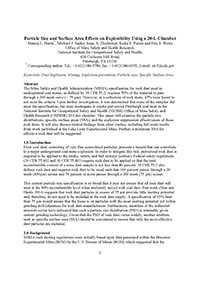Mining Publication: Particle Size and Surface Area Effects on Explosibility Using a 20-L Chamber
Original creation date: June 2015
The Mine Safety and Health Administration (MSHA) specification for rock dust used in underground coal mines, as defined by 30 CFR 75.2, requires 70% of the material to pass through a 200 mesh sieve (< 75 μm). However, in a collection of rock dusts, 47% were found to not meet the criteria. Upon further investigation, it was determined that some of the samples did meet the specification, but were inadequate to render pulverized Pittsburgh coal inert in the National Institute for Occupational Safety and Health (NIOSH) Office of Mine Safety and Health Research (OMSHR) 20-Liter chamber. This paper will examine the particle size distributions, specific surface areas (SSA), and the explosion suppression effectiveness of these rock dusts. It will also discuss related findings from other studies, including full-scale results from work performed at the Lake Lynn Experimental Mine. Further, a minimum SSA for effective rock dust will be suggested.
Authors: ML Harris, M Sapko, IA Zlochower, I Perera, ES Weiss
Peer Reviewed Journal Article - June 2015
NIOSHTIC2 Number: 20046504
J Loss Prev Process Ind 2015 Sep; 37:33-38
See Also
- A Centennial of Mine Explosion Prevention Research
- Coal Dust Explosibility
- Coal Dust Explosibility Meter Evaluation and Recommendations for Application
- The Explosibility of Coal Dust
- How Does Limestone Rock Dust Prevent Coal Dust Explosions in Coal Mines?
- Mitigating Coal Dust Explosions in Modern Underground Coal Mines
- Post-Explosion Observation of Experimental Mine and Laboratory Coal Dust Explosions
- Rock Dusting
- Rock Dusting Considerations in Underground Coal Mines
- Technology News 515 - Float Coal Dust Explosion Hazards
- Content source: National Institute for Occupational Safety and Health, Mining Program


 ShareCompartir
ShareCompartir
